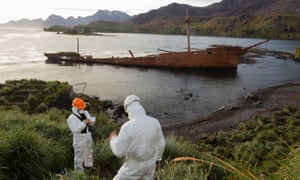From the Guardian
One wonders what they lived on ... and what is that interesting wreck?
South Georgia declared rat-free after centuries of rodent devastation
World’s biggest project to kill off invasive species to protect native wildlife is hailed a success
The world’s biggest project to eradicate a dangerous invasive species has been declared a success, as the remote island of South Georgia is now clear of the rats and mice that had devastated its wildlife for nearly 250 years.
Rats and mice were inadvertently introduced to the island, off the southern tip of South America and close to Antarctica, by ships that stopped there, usually on whaling expeditions. The effect on native bird populations was dramatic. Unused to predators, they laid their eggs on the ground or in burrows, easily accessible to the rodents.
Two species of birds unique to the island, the South Georgia pipit and pintail, were largely confined to a few tiny islands off the coast, which the rodents could not reach, and penguins and other seabird populations were also threatened.
Mike Richardson, the chair of the decade-long £10m project, said: “No rodents were discovered in the [final] survey. To the best of our knowledge, for the first time in two and a half centuries this island is rodent-free. It has been a long, long haul.”
The last of the poisoned bait was dropped more than two years ago, but scientists have spent the intervening period monitoring the island for rodents. Two experienced dog handlers from New Zealand walked three dogs – named Will, Ahu and Wai – across nearly 1,550 miles (2,500km) in often extreme weather, beset by heavy rain and often fierce storms, seeking out signs of rats and mice.
Only when none were found over the whole period and in every area was the project deemed a success according to international standards. The leaders of the eradication effort declared the island free of rats and mice on Wednesday, and said the air resounded with the once-rare song of the native pipit.
The project was led by the South Georgia Heritage Trust, a charity set up to protect the island, and an associate organisation, the US-based Friends of South Georgia Island. The UK government also played a role, but the bulk of the funding came from private fundraising and philanthropy.
Scientists hope the success could become an inspiration and model for other projects around the world to eliminate invasive species, which in the worst cases can drive native animals close to extinction.
Lord Gardiner, the parliamentary under secretary at the Department for Environment, Food and Rural Affairs, said: “We must not rest on our laurels. In our overseas territories, which make up 90% of the UK’s biodiversity, [many species] are highly vulnerable.”
The South Georgia programme involved dropping hundreds of tonnes of poisoned bait on areas known to be infested with rodents. Harsh weather, mountainous terrain and the island’s limited accessibility made the project fraught with danger.
At times, when scientists believed they had eradicated rats from one area, they returned from another nearby section of the island, meaning the poisoning regime had to begin again. Richardson paid tribute to the teams’ endurance and bravery.
South Georgia, one of the UK’s numerous overseas territories, was first noted by Captain Cook in 1775 on one of his voyages of discovery. It became a stop for the hundreds of whalers which plied the southern seas, providing shelter, dry land and a meeting site for ships that may have spent weeks or months without sight of land.
About 2,000 people lived on the island during whaling’s heyday, but today the main activities are centred on two scientific research stations run by the British Antarctic Survey. It was claimed for Argentina during the Falklands war, and a UK garrison was only withdrawn in 2001. The island is also known as the burial ground of the Antarctic explorer Sir Ernest Shackleton, who died there in 1922.
About 100 miles long, the island covers about 350,000 hectares (865,000 acres) and much of it is covered in snow and ice. The remainder is very mountainous. Some of the coastal regions have vegetation, which has provided a haven for seabirds, and the pipits and pintails.
Other species on the island include seals – 98% of the world’s population of fur seals breed here, and it is home to about half the global population of elephant seals – and four penguin species, including 450,000 breeding pairs of king penguins. All four of the penguin species are listed as threatened. About 30 million birds are thought to nest and raise chicks on the island, with 81 species recorded.
Invasive species are one of the worst threats to biodiversity around the world. When non-native species are introduced, often inadvertently but also sometimes as pets or ornamental features, they can disrupt natural ecosystems evolved over millennia to the detriment of the native species.
One classic example is the grey squirrel, introduced to Europe as a novelty and which has come close to eclipsing the native red in the UK. It was thought this was mainly because the more aggressive greys outcompeted the reds for habitats and food, but more recently scientists have discovered that a virus called squirrelpox, to which the natives have little resistance, also played a leading role.


No comments:
Post a Comment